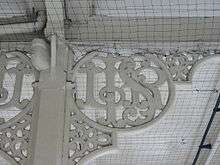LT&SR 79 Class
| LT&SR 79 class | |||||||||||||||||||||||||||||||||||
|---|---|---|---|---|---|---|---|---|---|---|---|---|---|---|---|---|---|---|---|---|---|---|---|---|---|---|---|---|---|---|---|---|---|---|---|
 Preserved LTSR 4-4-2T No. 80 Thundersley | |||||||||||||||||||||||||||||||||||
| |||||||||||||||||||||||||||||||||||
| |||||||||||||||||||||||||||||||||||
| |||||||||||||||||||||||||||||||||||
| |||||||||||||||||||||||||||||||||||
The London, Tilbury and Southend Railway (LTSR) 79 Class is a class of 4-4-2T suburban tank engines. They were designed by Thomas Whitelegg, as a development of the earlier 37 Class.
The four locomotives ordered by the LTSR were numbered 79–82 and were named after places in Essex, near the LTSR route. After absorption by the Midland Railway in 1912, they were renumbered 2176–2179 and their names were removed. The Midland gave them the power classification 3P, and later continued construction; an order for 10 locomotives was delivered in 1923, just after grouping.
List of LTSR locomotives
| LTSR No. | LTSR Name | Builder | Built | MR No. | LMS 1923 No. | LMS 1930 No. | BR No. | Withdrawn |
|---|---|---|---|---|---|---|---|---|
| 79 | Rippleside | RS 3366 | 1909 | 2176 | 2176 | 2147 | 41965 | 1951 |
| 80 | Thundersley | RS 3367 | 1909 | 2177 | 2177 | 2148 | 41966 | 1956 |
| 81 | Aveley | RS 3368 | 1909 | 2178 | 2178 | 2149 | 41967 | 1952 |
| 82 | Crowstone | RS 3369 | 1909 | 2179 | 2179 | 2150 | 41968 | 1951 |
Additional orders
In addition to those constructed by the LTSR and MR, 35 were delivered to the London, Midland and Scottish Railway (LMS) – ten in 1923, five in 1925, ten in 1927, and a final 10 in 1930. The ten delivered in 1923 were to an outstanding order placed by the MR, the remainder were ordered by the LMS.[1] The five delivered in 1925 were built by Nasmyth, Wilson and Company, with the other thirty built by the LMS's Derby Works. In 1947 the LMS assigned them the numbers 1928–1975, to clear their previous numbers for new LMS Fairburn 2-6-4T locomotives, but none of these was applied before nationalisation in 1948, leaving British Railways to apply the numbers 41928–41975.
| LMS Lot No. | Built | Builder | LMS No. | BR No. | Withdrawn |
|---|---|---|---|---|---|
| Lot 5 | 1923 | Derby Works | 2110–2119 | 41928–41937 | 1951–1959 |
| Lot 24 | 1925 | NW 1448–1452 | 2120–2124 | 41938–41342 | 1952–1959 |
| Lot 48 | 1927 | Derby Works | 2125–2134 | 41943–41952 | 1956–1960 |
| Lot 70 | 1930 | Derby Works | 2151–2160 | 41969–41978 | 1955–1959 |
They were later displaced from the London, Tilbury and Southend Railway and found work on ex-Midland lines in the East Midlands.
One, 80 Thundersley has been preserved and is on static display at the Bressingham Steam Museum in Norfolk.
References
- Casserley, H. C. & Johnston, Stuart W. (1974) [1966]. Locomotives at the Grouping 3: London, Midland and Scottish Railway. Shepperton, Surrey: Ian Allan. pp. 40–41. ISBN 0-7110-0554-0.
- Essery, Bob (2001). The London, Tilbury and Southend Railway and its Locomotives, OPC. ISBN 0-86093-561-2
- Essery, Bob and Jenkinson, David. An Illustrated History of LMS locomotives. Volume 4. Absorbed Pre-Group Classes Midland Division ISBN 0-947971-16-5
- Rowledge, J.W.P. (1975). Engines of the LMS. Oxford: Oxford Publishing Company. pp. 4, 42, 50. ISBN 0-902888-59-5.
